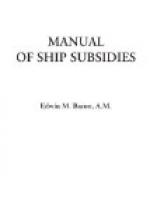This law increased the annual subsidy from four million marks as first proposed to four million four hundred thousand marks, of which one million seven hundred thousand was offered for the East Asian line, to China and Japan; two million three hundred thousand for the Australian line, and four hundred thousand for a branch line connecting Trieste with the Australian line at Alexandria. The contracts in accordance with it all went to the North German Lloyd Company, of Bremen. The convention between the Government and this company required that the new vessels to be furnished must be built in German yards and of German material. The coal supply was, as far as practicable, to be of German product. The chancellor was empowered to take over all the company’s steamers for the mobilization of the navy, at their full value, or on hire at proper compensation. The sale or loan of a steamer to a foreign power could be made only by permission of the chancellor. The number of voyages to be made on each line yearly, and the rate of speed, were set down in careful detail. Failure to observe the table of voyages, without sufficient reason, subjected the company to heavy penalties. All persons employed in connection with the mail service were, if practicable, to be German subjects. All officers in the service of the empire, relief crews, weapons, ammunition, equipments, or supplies for the imperial navy, were to be carried at twenty per cent under the regular tariff.[CM]
Subsequent laws made additions to the free list of raw and manufactured shipbuilding material; and preferential rates on the State railroads were arranged for the transportation of steel, iron, timber, from the interior, where these are found at an average distance of some four hundred miles from the coast, to the ship-yards.[CN] Speedily large and superior steamships were designed and turned out from the enlarged ship-yards, the first ocean flyer being the Auguste Victoria for the Hamburg-American Line. In 1890 a subsidy of ninety thousand marks annually was granted for an East African line on a ten-years’ contract. Within less than six years the establishment of a fortnightly Asiatic service was agitated; and in 1896 a bill granting a yearly subsidy of one million four hundred thousand marks therefor, was brought before the Reichstag. If this were forthcoming the North German Lloyd agreed, besides furnishing the fortnightly service, to increase the speed of their steamers, to send ships direct to Japan, and to meet all requirements of the Admiralty with respect to ships and crews.[CO]
Now the advocates of further subsidies maintained that the policy instituted with the law of 1885 had proved its effectiveness. The indirect advantages from the subventions were claimed to be quite as great as the direct. While before 1885 all large ships for German companies had been ordered in England, now all large ships for the German transatlantic lines were built in Germany.[CO] This condition, the increasing




